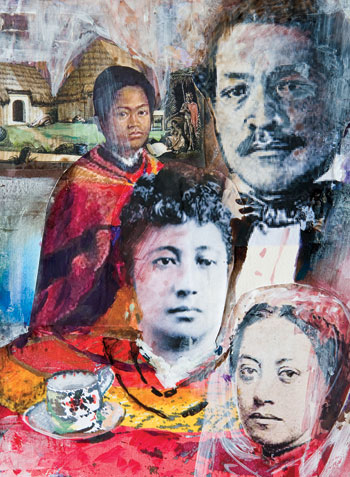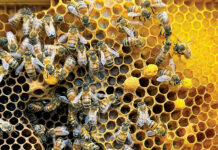Story by Paul Wood | Illustration by Al Lagunero
 In 1818, the aging King Kamehameha received a visitor, a Russian ship captain, who described the great Hawaiian warrior as dressed “in European fashion . . . light green velvet trousers, a white shirt, a silk kerchief around his neck, a coffee brown silk vest, white stockings and shoes, and a soft felt hat.” Having retired to Kailua-Kona, the king lived the old way, in a traditional thatch halau. Next door, though, he kept a very Western-style stone warehouse, in which he stored his loot—gunpowder, rum, and no doubt the other Western goods popular with the ali‘i (chiefs), such as gilt-framed mirrors, silver tea sets, medal-bedecked nautical uniform jackets, delicately carved writing desks, swords and goblets, spittoons, and loads of English-milled fabrics—the rhythmic beating of kapa (bark cloth) now having gone silent across the Islands. The missionaries hadn’t arrived yet, but the inevitable decline of native traditions was already well under way.
In 1818, the aging King Kamehameha received a visitor, a Russian ship captain, who described the great Hawaiian warrior as dressed “in European fashion . . . light green velvet trousers, a white shirt, a silk kerchief around his neck, a coffee brown silk vest, white stockings and shoes, and a soft felt hat.” Having retired to Kailua-Kona, the king lived the old way, in a traditional thatch halau. Next door, though, he kept a very Western-style stone warehouse, in which he stored his loot—gunpowder, rum, and no doubt the other Western goods popular with the ali‘i (chiefs), such as gilt-framed mirrors, silver tea sets, medal-bedecked nautical uniform jackets, delicately carved writing desks, swords and goblets, spittoons, and loads of English-milled fabrics—the rhythmic beating of kapa (bark cloth) now having gone silent across the Islands. The missionaries hadn’t arrived yet, but the inevitable decline of native traditions was already well under way.
Four decades of contact had elapsed. A lot can happen in forty years, especially if one’s leaders are quick to amass the luxuries and tools of a new world order (and Kamehameha certainly was). From this point, only seventy-five years remained—two generations—before his young kingdom would be snuffed out by an armed insurrection of foreigners. The great irony of the Kamehameha dynasty lies in its embrace of Western ways, a stratagem that not only brought it to power but also slowly tore it apart from within.
You can see a tragic awareness in the eyes of all the royals who followed the old king. For example, a portrait from 1852 centers on Kamehameha III, the founder’s younger son, who by this date was thirty-eight years old and had been king for twenty-seven of them. (He would die two years later.) His arms are crossed high and tight across his chest, his natural expression ferocious, his eyes cast slightly to the side as though he is pained with melancholy regret. By his side are his queen, Kalama, and their daughter, Princess Victoria Kamamalu. (She would be dead before her turn to rule.) Behind him stand his two hanai (adopted) sons, proud twenty-ish lads destined to become the successors to the throne. The dress is Victorian. The men wear coats and vests, high collars bound with flowing ties. The women are in dark formal evening wear, arms fully ensleeved, the somewhat revealing “bertha” necklines moderated (in the princess’s case) by a shawl and a strip of lace secured about the neck with a brooch. In vivid contrast to such finery is the fury burning in their faces, as though each of them had long since run out of tears. You think of an eagle in a cage, or of a hero finally facing the firing squad of his enemy.
Who is this “enemy”?
Death, for one thing. Kamehameha III had lost his father at age five, his mother at age nine, his older brother at age eleven, his beloved sister at age twenty-two. All but one of his own children had died in infancy. The Western world had provided not only gunpowder, rum, and crinoline, but also measles, pox, and every other form of pestilence. It is impossible to overstate the spiritual desolation that must have haunted the Kamehameha royals as they saw death after death shrink the Hawaiian population—90 percent is the most conservative estimation of this loss over the span of the kingdom.
Then there was the problem of compromise. You can’t draw a line in the sand when you’re climbing an avalanche. Just before her death, Kamehameha III’s mother, Keopuolani, had taken baptism—the first ali‘i to do so—and had given the missionaries custody over her children and indeed over her people. The little boy was the age of a fourth-grader at the time. He grew into a rebellious youth, expressing much of that rebellion through boozing. But his mature decisions—the constitutional monarchy, the land giveaway known as the Great Mahele—were the compromises of harsh necessity. In 1843, the British commander George Paulet captured Hawai‘i and hung the Union Jack over the kingdom for five months before the Americans and the French forced him to back off. After that incident, everyone could see that the Islands were low-hanging fruit.
In the middle of his reign, the king moved to secure the dynasty by providing for the education and selection of his successors, and he did this in a way that would have pleased his convert mother. In 1839 he established the Chiefs’ Children’s School, a boarding school located at the site of the present state capitol. He picked fourteen children to attend—seven boys, seven girls—and from their ranks came five later monarchs. The teachers charged with grooming these children for the throne were a missionary couple, Amos Starr and Juliette Montague Cooke. She was particularly fond of music, as were here pupils. The school was a two-story frame building with a New England style parlor, a formal dining room, and separate sleeping quarters for the royal children and their surrogate parents. The students could as well have been in Hartford or Cambridge as in Honolulu.
Among the youngest of these “royals” was David Kalakaua, who would be elected king in 1873—the last Hawaiian king, as it turned out. Applying all the moxie of his predecessor the first Kamehameha, he adopted a conciliatory stance with the Western world, then went about creating a legacy that would make Hawaiians stand proud no matter what should befall his people. He wrote books (among them The Legends and Myths of Hawaii), he traveled the world, and he encouraged his people to celebrate their culture and to perpetuate the race by having children. He created a navy (a fiasco), and most of all he built a magnificent palace. I think of this palace as a last-minute eruption of poetic defiance, a boulder thrown into the grinding gears of grim progress. Citizens of foreign blood resented the expense of building ‘Iolani Palace (over $350,000) and related luxuries (a coronation that cost $50,000, lasted two weeks, and included performances of the once-banished art of hula.) This resentment probably hastened the inevitable fall of the kingdom. But most native Hawaiians at the time defended the significance of his actions. And now ‘Iolani Palace daily proclaims that the culture it symbolizes will endure.
It was the royal men who made such grand gestures and drastic decisions. In the long run, though, the survival of Hawaiian people and culture can be credited mostly to the royal women.
Bernice Pauahi is the great “what if” of the dynasty.
Almost immediately upon the death of Kamehameha I, Hawaiian culture shifted away from its reliance on male muscle in armed combat. Warriors were no longer useful in a world run by palapala (book learning), financial negotiations, and visiting gunboats bearing insuperable arms. As soon as the old king had expired, two of his wives scuttled the entire kapu system (the laws and practices that governed every aspect of life in the old days) by sitting down to a mixed-gender banquet full of foods previously forbidden to women. One of these wives, Ka‘ahumanu, declared herself kuhina nui—a new title that made her the de facto ruler of the kingdom. Both she and Keopuolani (the other wife and the highest ranked woman in the Islands) converted to Christianity and seemed determined to steer the ship of state directly into the mainstream of world civilization.
These two female visionaries (both of whom were native to Maui, by the way) inspired two subsequent generations of royal women. Of the seven young women sent to board at the Chiefs’ Children’s School, only one was destined to become queen—that was, of course, Lili‘uokalani, Kalakaua’s sister, the last of Hawai‘i’s monarchs. But all of these princesses are to be admired.
Emma Na‘ea Rooke, for example, is best remembered now for her lifetime of charitable work, especially the establishing of Queen’s Hospital to ease the terrible suffering of her people. Both in upbringing and in DNA she was a Hawaiian-English hybrid. (John Young, the British sailor who became an ali‘i, was her grandfather.) Her beauty matched her dignity and sophistication. When Kamehameha IV took the throne at age twenty-two, he wooed his former schoolmate Emma, who was two years younger. They married in 1856 and two years later produced an heir. Prince Albert’s birth seemed to suggest that the royal line could perpetuate itself in storybook fashion, but this was not to be. The child died at age four. The king himself died in Emma’s arms one year later, leaving her a widow at age twenty-seven. After that, “Queen Emma” made two attempts to take the throne. The second, in which she vied with Kalakaua, was so hotly contested that she withdrew simply to save her people from civil war. Being pro-British, she despised the creeping influence of the American planters. In a letter she wrote, “The sudden and bold uncovering of America’s long cherished wish to possess these Islands has caused me great, great grief and anxiety. I consider that America is now our open enemy. The Native Hawaiians are one with me in the love of our country and determined not to let Hawai‘i become a part of the United States of America.”
Another girl of the Chiefs’ Children’s School never aspired to the throne, but made a choice that has done more for the perpetuation of her people and culture than perhaps any of the other royals. Bernice Pauahi is the great “what if” of the dynasty, a great-granddaughter of the old warrior and, childless herself, the last of his direct lineage. She inherited one-ninth of Hawai‘i’s land. Offered the throne by her cousin the fifth Kamehameha, she declined it. Had she accepted, she could have applied a tremendous personal fortune to the job of ruling the Hawaiian kingdom. Perhaps she could have stood with greater resolution against the forces that led to the overthrow; who can say? She chose instead to elope to Kaua‘i with a handsome American named Charles R. Bishop. Bishop became a naturalized citizen of Hawai‘i, went into banking, and amassed his own fortune. Both gave their legacies to the Hawaiian people in nonpolitical ways—he by endowing the Bernice Pauahi Bishop Museum, and she by establishing Bishop Estate and Kamehameha Schools. That museum today is the preeminent guardian of Hawai‘i’s past; those schools, which teach some 6,500 Hawaiian students each year, are fulfilling Pauahi’s desire to ensure her people’s future.
The story of the Kamehameha royals denies fairy tales, but proves the emotional accuracy of Shakespeare’s plays—a crown is not the kind of headgear most people want to wear. Royalty comes with a guarantee that people will be talking about you years later, using the word “tragedy” a lot. And another word, truly earned—nobility.
Legacy of the Royals
Queen Emma’s Summer Palace
Built in 1847, the restored and furnished home of Queen Emma and King Kamehameha IV offers a glimpse into the lifestyle of the Hawaiian monarchy.
Located at 2913 Pali Highway, this historic home is open Monday through Friday, 8:30 am to 4 pm. Admission $6 (less for children and seniors). Reservations not necessary.
Hulihe‘e Palace
Kailua-Kona’s only existing royal residence, this structure was built for high chief Kuakini, governor of Hawai‘i Island, in 1838. The house became a favorite getaway for King Kalakaua and his Queen Kapi‘olani. But the progress-resistant granddaughter of Kamehameha, the admirable Princess Ruth Ke‘elikolani, refused to live indoors. She dwelt instead in a pili-grass house on the palace grounds.
Now a museum, the palace is open Wednesday through Saturday from 10 a.m. to 3 p.m. Self-guided-tour brochures are available in many languages. Guided tours occur frequently throughout the day.
Bishop Museum
Everything you want to know about Hawai‘i can be found at the Bishop Museum, whose Hawaiian Hall reopened last August after its first major renovation in more than a century. Museum displays include a room full of the kahili (the symbolic feathered standards of royalty) representing every member of the Kamehameha lineage. But that’s just the beginning of the exploration.
Admission $14.95; open daily from 9 a.m. to 5 p.m.
‘Iolani Palace
You can’t truly know the story of Hawai‘i without having spent time in this sensational building, which includes not only the carefully controlled guided tour of the principal rooms (they provide little booties to put over your shoes), but also the self-directed time in the basement “galleries,” which contain artifacts of opulence and of myth.
Dawdle in the room where Lili‘uokalani underwent weary months of house arrest. You will feel her story.
Completed in 1882, the palace endured a lot of not-so-respectful uses after the 1893 overthrow. But a fervent restoration campaign begun in the 1960s has returned the entire structure to King Ka¯akaua’s vision.
Reservations highly recommended. Call (808) 522-0832.
Tour tickets cost $20 ($15 kama‘aina), $5 for children five to seventeen (under five not accommodated). Tours run every thirty minutes from 8:30 a.m. to 2 p.m.
The self-guided galleries tour is open from 9 a.m. to 4 p.m. Tickets are $10 for adults ($5 kama‘aina) and $5 for children ages five to seventeen. Children under five are admitted free.





